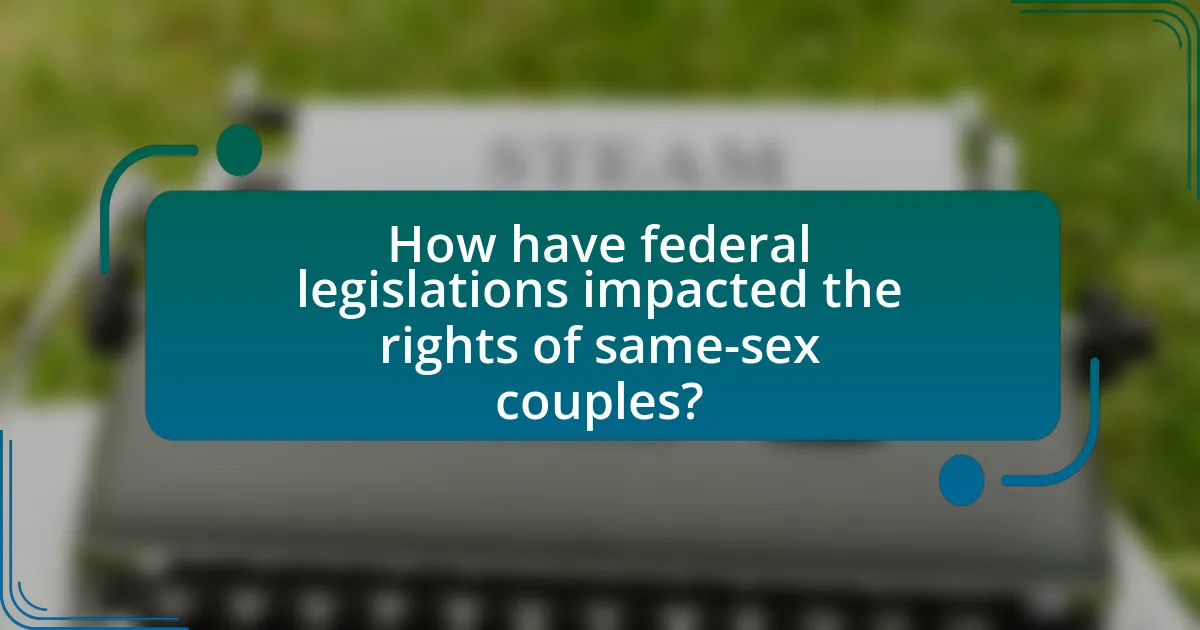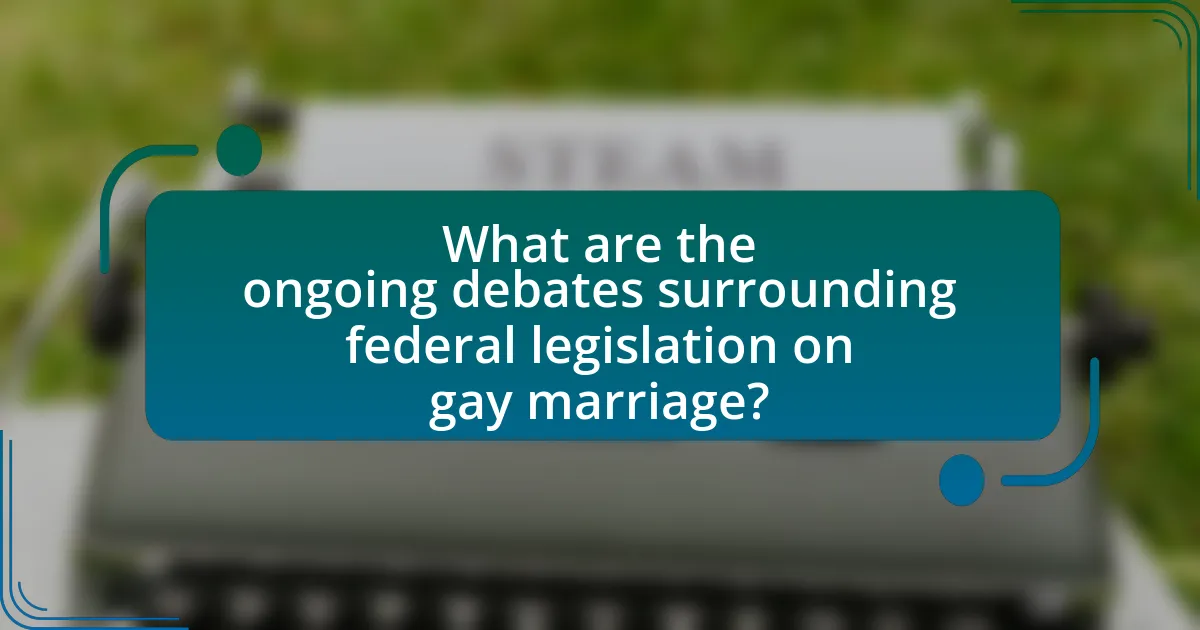The article analyzes the effects of federal legislation on gay marriage, focusing on key laws such as the Defense of Marriage Act (DOMA) and the landmark Supreme Court decision Obergefell v. Hodges. It outlines how DOMA initially defined marriage as a union between one man and one woman, denying federal recognition to same-sex marriages, and discusses the subsequent legal challenges that led to the invalidation of DOMA’s provisions. The article further examines the implications of these legal changes on the rights of same-sex couples, public perception, ongoing debates, and potential future legislative developments affecting marriage equality in the United States.

What are the key federal legislations affecting gay marriage?
The key federal legislations affecting gay marriage include the Defense of Marriage Act (DOMA) and the Obergefell v. Hodges Supreme Court decision. DOMA, enacted in 1996, defined marriage for federal purposes as the union between one man and one woman, effectively denying federal recognition of same-sex marriages. However, the Supreme Court’s ruling in Obergefell v. Hodges in 2015 declared that same-sex marriage is a constitutional right under the Fourteenth Amendment, thereby invalidating DOMA’s definition and requiring all states to recognize same-sex marriages. This landmark decision fundamentally changed the legal landscape for gay marriage in the United States.
How did the Defense of Marriage Act (DOMA) influence gay marriage laws?
The Defense of Marriage Act (DOMA) influenced gay marriage laws by defining marriage at the federal level as a union between one man and one woman, which effectively denied federal recognition of same-sex marriages. This legal framework led to significant barriers for same-sex couples seeking federal benefits and protections, as they were excluded from over 1,000 federal rights associated with marriage. The act’s provisions prompted numerous legal challenges, culminating in the Supreme Court’s 2013 decision in United States v. Windsor, which struck down key sections of DOMA, paving the way for greater acceptance and legalization of same-sex marriage across various states. This landmark ruling significantly shifted the legal landscape, ultimately contributing to the nationwide legalization of gay marriage in 2015 through Obergefell v. Hodges.
What were the main provisions of DOMA?
The main provisions of the Defense of Marriage Act (DOMA) included the definition of marriage as a union between one man and one woman for federal purposes and allowed states to refuse recognition of same-sex marriages performed in other states. Specifically, DOMA was enacted in 1996 and aimed to prevent federal recognition of same-sex marriages, thereby denying federal benefits to same-sex couples. The law was partially struck down by the Supreme Court in 2013, which ruled that the federal government could not deny benefits to legally married same-sex couples, affirming that DOMA’s definition of marriage was unconstitutional.
How did DOMA impact state-level marriage laws?
The Defense of Marriage Act (DOMA) significantly impacted state-level marriage laws by allowing states to refuse recognition of same-sex marriages performed in other states. This federal legislation, enacted in 1996, defined marriage as a union between one man and one woman for federal purposes, which led many states to adopt similar definitions in their own laws. Consequently, states were empowered to enact laws that explicitly prohibited same-sex marriage, resulting in a patchwork of marriage laws across the country. For instance, by 2004, several states had passed constitutional amendments banning same-sex marriage, influenced by the federal stance established by DOMA. This created legal uncertainty and discrimination against same-sex couples, as they were denied the same rights and benefits afforded to heterosexual couples under state law.
What role did the Supreme Court play in shaping gay marriage legislation?
The Supreme Court played a pivotal role in shaping gay marriage legislation by ruling on key cases that established the constitutional right to same-sex marriage. In 2015, the Court’s decision in Obergefell v. Hodges legalized same-sex marriage nationwide, affirming that the right to marry is a fundamental liberty protected by the Fourteenth Amendment. This ruling built upon earlier decisions, such as United States v. Windsor in 2013, which struck down the Defense of Marriage Act’s definition of marriage as solely between one man and one woman, thereby invalidating federal discrimination against same-sex couples. These landmark cases collectively transformed the legal landscape for gay marriage in the United States.
What was the significance of the United States v. Windsor case?
The significance of the United States v. Windsor case lies in its ruling that the Defense of Marriage Act (DOMA) was unconstitutional, thereby affirming federal recognition of same-sex marriages. This landmark decision, issued by the Supreme Court in 2013, invalidated the provision of DOMA that denied federal benefits to legally married same-sex couples, which had significant implications for the legal status and rights of these couples across the United States. The ruling established a precedent that contributed to the broader movement for marriage equality, ultimately leading to the legalization of same-sex marriage nationwide in 2015 through Obergefell v. Hodges.
How did Obergefell v. Hodges change the legal landscape for gay marriage?
Obergefell v. Hodges fundamentally changed the legal landscape for gay marriage by establishing that same-sex couples have a constitutional right to marry under the Fourteenth Amendment. This landmark Supreme Court decision, issued on June 26, 2015, invalidated state bans on same-sex marriage and required all states to recognize same-sex marriages performed in other jurisdictions. The ruling was based on principles of equal protection and due process, affirming that denying marriage rights to same-sex couples was discriminatory. As a result, Obergefell v. Hodges effectively legalized same-sex marriage nationwide, ensuring that same-sex couples receive the same legal benefits and recognition as heterosexual couples.

How have federal legislations impacted the rights of same-sex couples?
Federal legislation has significantly expanded the rights of same-sex couples, particularly through the legalization of same-sex marriage and the recognition of their legal status. The landmark Supreme Court decision in Obergefell v. Hodges (2015) established that same-sex marriage is a constitutional right under the Fourteenth Amendment, thereby requiring all states to recognize such marriages. This ruling followed the enactment of the Defense of Marriage Act (DOMA) in 1996, which initially defined marriage as a union between one man and one woman; however, key provisions of DOMA were struck down by the Supreme Court in United States v. Windsor (2013), allowing federal recognition of same-sex marriages performed in states where they were legal. Consequently, federal legislation has played a crucial role in affirming the legal rights of same-sex couples, including access to benefits, tax filings, and inheritance rights, thereby promoting equality and protection under the law.
What legal rights are granted to same-sex couples under federal law?
Same-sex couples are granted legal rights under federal law that include the right to marry, access to federal benefits, and protections against discrimination. The landmark Supreme Court decision in Obergefell v. Hodges (2015) established that same-sex marriage is a constitutional right, thereby ensuring that same-sex couples can legally marry in all states. This ruling also allows same-sex couples to access federal benefits such as Social Security, tax benefits, and health care coverage that are available to heterosexual couples. Additionally, federal laws like the Employment Non-Discrimination Act (ENDA) provide protections against workplace discrimination based on sexual orientation, further solidifying the legal rights of same-sex couples.
How do federal benefits for same-sex couples compare to those for heterosexual couples?
Federal benefits for same-sex couples are now largely comparable to those for heterosexual couples due to the Supreme Court’s 2015 decision in Obergefell v. Hodges, which legalized same-sex marriage nationwide. This ruling mandated that same-sex couples receive the same federal benefits as heterosexual couples, including tax benefits, Social Security survivor benefits, and health care coverage. Prior to this ruling, same-sex couples faced significant disparities in access to these benefits, often being denied rights such as joint tax filing and spousal benefits. The legal recognition of same-sex marriage has thus aligned federal benefits, ensuring equality under the law for both same-sex and heterosexual couples.
What challenges do same-sex couples still face despite federal recognition?
Same-sex couples still face significant challenges despite federal recognition, including discrimination in various sectors, lack of state-level protections, and social stigma. For instance, many states do not have comprehensive anti-discrimination laws that protect LGBTQ+ individuals in employment, housing, and public accommodations, leading to unequal treatment. According to a 2021 report by the Human Rights Campaign, 29 states lack explicit protections against discrimination based on sexual orientation or gender identity. Additionally, same-sex couples may encounter difficulties in areas such as healthcare access, adoption rights, and family law, where legal recognition does not guarantee equitable treatment. Social stigma and bias can also result in mental health challenges, as studies indicate higher rates of anxiety and depression among LGBTQ+ individuals compared to their heterosexual counterparts.
How have federal legislations affected public perception of gay marriage?
Federal legislation has significantly influenced public perception of gay marriage by legitimizing same-sex unions and promoting acceptance. The landmark Supreme Court decision in Obergefell v. Hodges (2015) legalized gay marriage nationwide, leading to increased visibility and normalization of same-sex relationships in society. Following this ruling, public support for gay marriage rose from approximately 40% in 2008 to over 60% by 2020, according to Gallup polling data. This shift indicates that federal recognition has played a crucial role in changing attitudes, fostering a more inclusive environment for LGBTQ+ individuals.
What trends in public opinion have emerged following key legislative changes?
Following key legislative changes regarding gay marriage, public opinion has increasingly shifted towards acceptance and support for same-sex marriage. For instance, a Gallup poll conducted in 2021 indicated that 70% of Americans supported same-sex marriage, a significant increase from 27% in 1996 when the Defense of Marriage Act was enacted. This trend reflects a broader societal change, influenced by legislative milestones such as the Supreme Court’s 2015 decision in Obergefell v. Hodges, which legalized same-sex marriage nationwide. Additionally, younger generations consistently show higher levels of support, with 83% of millennials favoring same-sex marriage, indicating a generational shift in attitudes that aligns with legislative progress.
How do media portrayals influence public attitudes towards gay marriage?
Media portrayals significantly influence public attitudes towards gay marriage by shaping perceptions and normalizing LGBTQ+ relationships. Research indicates that positive representation in television and film correlates with increased acceptance of gay marriage among viewers. For instance, a study published in the Journal of Homosexuality found that exposure to LGBTQ+ characters in popular media led to more favorable attitudes towards same-sex marriage, particularly among younger audiences. This effect is amplified when media narratives humanize LGBTQ+ individuals, fostering empathy and understanding, which in turn can lead to shifts in public opinion and support for legislative changes regarding gay marriage.

What are the ongoing debates surrounding federal legislation on gay marriage?
Ongoing debates surrounding federal legislation on gay marriage primarily focus on the balance between state rights and federal authority, the implications for religious freedoms, and the potential for discrimination. Proponents argue that federal legislation is necessary to ensure equal rights and protections for same-sex couples across all states, especially in light of varying state laws following the Supreme Court’s decision in Obergefell v. Hodges (2015), which legalized same-sex marriage nationwide. Opponents express concerns that such legislation could infringe on religious liberties, arguing that it may compel religious organizations to act against their beliefs. Additionally, discussions include the potential for backlash in conservative states, where local laws may seek to undermine federal protections. These debates reflect broader societal attitudes toward LGBTQ+ rights and the evolving legal landscape in the United States.
What arguments do opponents of gay marriage legislation present?
Opponents of gay marriage legislation argue that it undermines traditional marriage, which they define as a union between one man and one woman. They claim that allowing same-sex marriage could lead to a redefinition of marriage that may open the door to polygamy and other non-traditional unions. Additionally, they assert that legalizing gay marriage could negatively impact religious freedoms, as individuals and organizations may be compelled to act against their beliefs. Furthermore, some opponents argue that children do best when raised by a mother and a father, suggesting that same-sex couples cannot provide the same family structure. These arguments are often supported by various religious and cultural beliefs that emphasize the sanctity of heterosexual marriage.
How do religious beliefs influence opposition to gay marriage?
Religious beliefs significantly influence opposition to gay marriage by framing it as contrary to traditional moral values. Many religious groups interpret sacred texts as condemning same-sex relationships, leading to a belief that marriage should only be between a man and a woman. For example, in Christianity, passages from the Bible, such as Leviticus 18:22, are often cited to support this view. Additionally, surveys indicate that individuals who regularly attend religious services are more likely to oppose gay marriage, reflecting the strong correlation between religious adherence and conservative views on marriage. This opposition is further reinforced by religious organizations actively campaigning against the legalization of gay marriage, mobilizing their followers to advocate for policies that align with their beliefs.
What are the legal arguments against federal recognition of gay marriage?
Legal arguments against federal recognition of gay marriage primarily center on the interpretation of the Constitution and states’ rights. Opponents argue that the Constitution does not explicitly guarantee the right to marry for same-sex couples, thus leaving the definition of marriage to individual states. This perspective is supported by the Tenth Amendment, which reserves powers not delegated to the federal government to the states. Additionally, some legal arguments invoke the Defense of Marriage Act (DOMA), enacted in 1996, which defined marriage as a union between one man and one woman for federal purposes, asserting that states should have the authority to regulate marriage without federal interference. These arguments emphasize the belief that marriage laws should reflect the values and beliefs of individual states rather than a federal mandate.
What future changes in federal legislation could impact gay marriage?
Future changes in federal legislation that could impact gay marriage include potential amendments to the Defense of Marriage Act (DOMA) or the introduction of new laws that either protect or restrict marriage equality. For instance, if Congress were to pass legislation that explicitly defines marriage as between one man and one woman, it would directly undermine the legal standing of same-sex marriages established by the Supreme Court’s ruling in Obergefell v. Hodges in 2015. Conversely, legislation aimed at reinforcing protections for same-sex marriage, such as the Equality Act, could further solidify marriage rights for LGBTQ+ individuals. These legislative changes would significantly influence the legal landscape surrounding gay marriage in the United States.
How might upcoming Supreme Court cases affect gay marriage rights?
Upcoming Supreme Court cases could significantly impact gay marriage rights by potentially revisiting or overturning precedents established in landmark decisions like Obergefell v. Hodges, which legalized same-sex marriage nationwide in 2015. If the Court decides to hear cases challenging the constitutionality of same-sex marriage or related rights, it could lead to a reevaluation of the legal protections afforded to same-sex couples. Historical context shows that the Supreme Court has the authority to alter or reaffirm existing rights, as seen in cases like Roe v. Wade, which was overturned in 2022, demonstrating the Court’s capacity to change established legal frameworks.
What legislative proposals are currently being discussed in Congress?
Currently, Congress is discussing several legislative proposals related to gay marriage, including the Equality Act and the Respect for Marriage Act. The Equality Act aims to amend the Civil Rights Act to prohibit discrimination based on sexual orientation and gender identity, thereby providing comprehensive protections for LGBTQ+ individuals. The Respect for Marriage Act seeks to ensure that same-sex marriages are recognized at the federal level, regardless of state laws. These proposals reflect ongoing efforts to solidify and expand legal protections for gay marriage in response to potential challenges to existing rights.
What practical steps can advocates take to support gay marriage rights?
Advocates can support gay marriage rights by engaging in grassroots organizing to mobilize community support and raise awareness. This includes hosting educational events, creating informational materials, and utilizing social media platforms to disseminate messages about the importance of marriage equality. Research indicates that public support for gay marriage has increased significantly, with a 2021 Gallup poll showing that 70% of Americans favor legalizing same-sex marriage, highlighting the effectiveness of advocacy efforts in shifting public opinion. Additionally, advocates can collaborate with legal organizations to provide resources and support for individuals facing discrimination, thereby reinforcing the legal framework that protects marriage rights.


